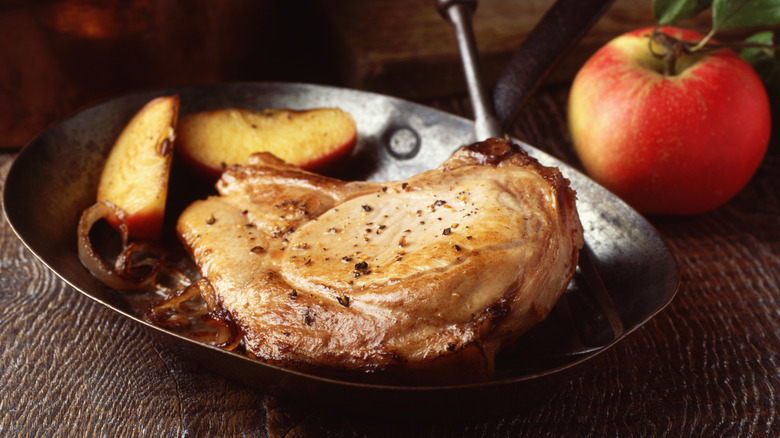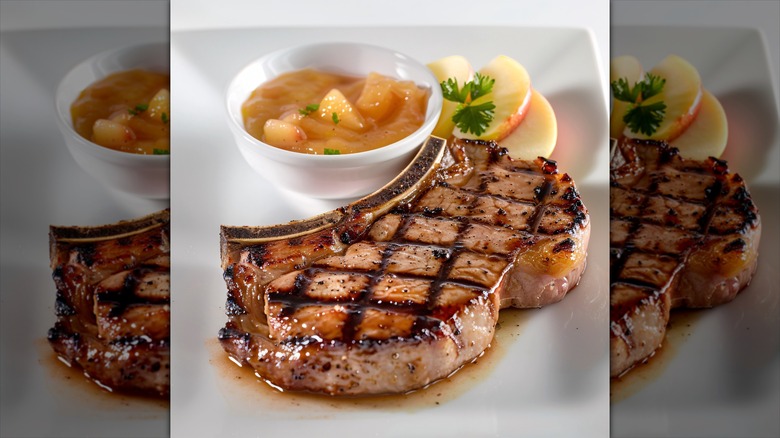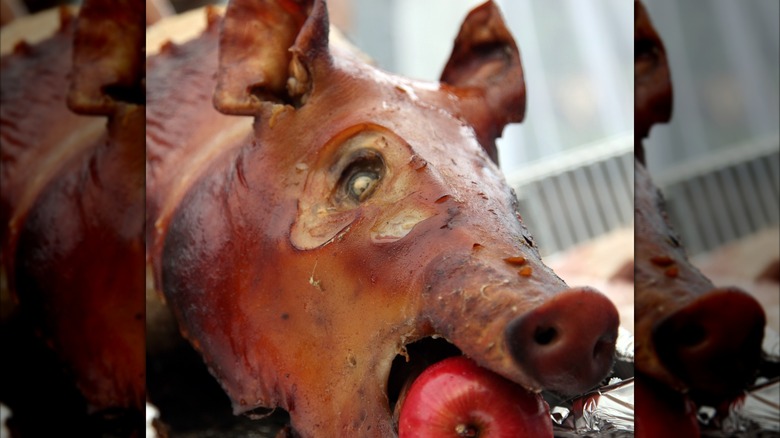Why Pork And Apples Are A Classic Pairing
Few images represent the opulence of the fall feast quite as much as the roast pig with an apple in its mouth. To the modern viewer, the apple pacifier in the pig's mouth just serves to make the swine's gaping mandibles look nicer, and while this is certainly a benefit, the pairing of pork and apples goes beyond optics. Seasonality. Flavor. Tenderness. All of these elements work together to make this meat-and-fruit pairing both logical and delicious. It's also a time-tested combo that goes back hundreds, if not thousands, of years, all the way to that famous ancient Roman gourmand, Apicius.
In more ancient days, farmers fed their pigs a steady diet of apples to not only fatten them up but to sweeten the meat, a lavish meal they would have enjoyed once fall harvest rolled around. Conveniently, apples, (and certain onions, another common ingredient served with the pork-and-apple mash-up), hit their peak ripeness in the fall. From a practical perspective, if ancient cooks wanted flavorful pork in the fall, roasting and even curing pigs with either apples or applewood smoke made sense. Cooking these ingredients together in myriad pork dishes in a variety of cuts was a logical next step.
A tasty association
Apples make pork meat taste sweeter by providing the raw material necessary for the umami-sweet flavor combination that makes the dish memorable. Many autumn recipes call for cooking chunks of apples, and sometimes, onions, in with the pork. In the simplest form, sticky-sweet pork chop recipes were cooked together with apples and their juice (or, at least, paired with applesauce as "The Brady Bunch" taught us).
In more elaborate set-ups, slices of apples, bulbs of garlic, and sliced onions are placed inside the bodily cavity of a young pig cooked on a spit. The heat breaks down the fruits and veggies inside the pig, infusing the meat with the savory sweetness of the stuffing. Still, many apples don't break down into mush when cooked, leaving the chef with fruitful chunks to serve as a side to the pork. (These are often Jonagold or Honeycrisp, the same apples that work best in apple pies.)
It's also worth mentioning that apples make a good marinade because the juice breaks down the meat, making it more tender. While it's common to see pork marinated in apple juice or cider, the juice from apples works so well as a marinade, steak even sometimes gets marinated in it.
Apples save face
Roasting pigs on a spit does all kinds of good things to the meat's flavor. It also does wonders for tenderizing the meat, particularly if a lechón, or suckling pig, is involved. While it's possible to cook an adult pig until the meat is tender, the meat of a young pig starts out tender and becomes even more tender when it's treated with apples and other tenderizers. From the home chef's perspective, it's a definite win. There is a downside, however, is the animal's gaping mouth.
The pig's mouth begins to cave in as the meat cooks, making the pig look less-than-palatable. However, that's not all. Something's happening in the pig's interior, too. The meat doesn't roast as well if there isn't some sort of valve, for lack of a better term, to allow the steam brewing inside the pig's body to escape. Stuffing the mouth of the pig with an apple gives steam its escape valve and turns the pig pretty in time for supper. And while it may be less pretty than, say, putting lipstick on the pig, shoving an apple in the pig's mouth keeps the jaw open and the pig pretty, well, as pretty as a spitted pig is going to be. Apples really are pork's best friend.


